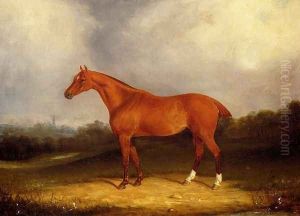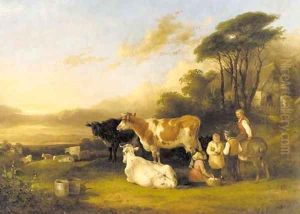William Shayer, Jr. Paintings
William Joseph Shayer Junior was an English landscape and animal painter born on April 25, 1811, in Southampton, Hampshire, England. He was the son of William Shayer Senior, who was also a well-known landscape painter of the 19th century. This familial connection provided the younger Shayer with a strong artistic foundation, as he learned much of his craft from his father. His father's influence was evident in his early works, which often depicted the bucolic landscapes and rural life of southern England, particularly the New Forest area near their home.
Growing up in a household steeped in artistic tradition, William Shayer Jr. worked closely with his father and often collaborated with him on paintings, a common practice at the time for enhancing production and learning. Despite the similarities in their subject matter, William Jr. developed his own style and gained recognition for his ability to capture the ambiance of the English countryside and the daily life of its inhabitants.
Throughout his career, Shayer Jr. exhibited at major art institutions such as the British Institution, the Royal Academy, and the Suffolk Street Gallery of the Society of British Artists. His works were well-received, and he enjoyed the patronage of art collectors and enthusiasts who appreciated his realistic portrayal of rural scenes, including livestock and agricultural activities. Unlike his father, who remained more regionally recognized, William Jr. gained wider acclaim in Britain.
William Shayer Jr. lived during the Victorian era, a period that saw significant changes in the art world, with the rise of new artistic movements and the advent of photography. Despite these changes, he remained committed to traditional landscape painting throughout his life. He continued to paint and exhibit his work until his death on December 29, 1892. His paintings remain part of the collections of various British art galleries and continue to be appreciated for their contribution to the depiction of 19th-century English rural life.


